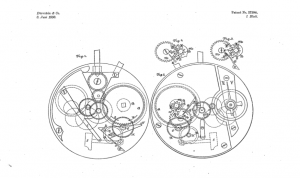Alarm Watches
Alarm Watches
Early History

There are individual alarm pocket watches dating back to the 17th Century and water clocks going back even further but it wasn't until 1899 when the Durrstein brothers patented the first mass-produced movement with an alarm complication. The large size of a pocket watch caliber allowed the brothers the freedom to use an extra large main spring that could power both the timekeeping of the watch and the alarm complication, which at full charge could chime for thirty seconds.
Early 20th Century Developments
The basic architecture of the alarm complication was now set for the next one hundred years; an independent alarm hand could be set to any time in a twelve hour period and was connected to a notched cam underneath the dial. When the desired time was met, the cam activated a lever, releasing energy from the mainspring to power a hammer to strike against a membrane creating sound. The alarm would ring, the time would be reset, the mainspring wound and the process would repeat. The alarm complication is different from a sonnerie or minute repeater despite the commonality of using sound to announce time. A sonnerie is a non-actionable complication that chimes the hour and quarter hour regardless of input from the wearer and a minute repeater is an actionable complication that chimes the hour and exact minute when the wearer activates the complication. In comparison, an alarm is a semi-actionable complication as the user initially sets the alarm time but has no input until the alarm chimes and then, depending on the watch, they can stop the alarm from chiming. Whilst a sonnerie and minute repeater use pitched bells to differentiate from hours and minutes, an alarm has a single, continuous pitch no matter the announced time.
Improving upon the original method of a setting key, the alarm was now controlled by rotating the bezel until the alarm hand aligned with the intended time. Four years later, Eterna would patent a bi-directional bezel and in 1914 would produce an alarm wristwatch based off the Durrstein's caliber however the small size of a wristwatch case presented problems: a smaller mainspring reduced the alarm time to just seven seconds, the bezel was likely to get knocked causing the alarm time to change and alarms vibrations caused problems with the accuracy of the movement. There were other attempts to create alarm wrist watches with one rather creative method of having the watch strap tighten against the wrist to alert the wearer. Needless to say this method did not catch on and it wouldn't be until the 1940's when real advancements were made.
